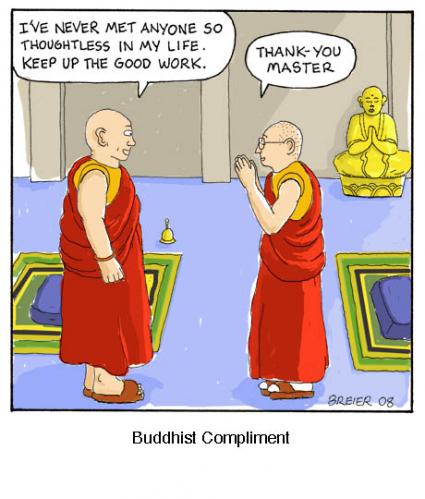Monday, March 7, 2011
Stereotype Blog
Breier. (2008). Buddhist Compliment. [online]
Available: http://www.toonpool.com/user/1688/files/buddhist_compliment_321115.jpg
March 7, 2011
The assignment this week was to find some kind of image, video clip, etc that shows an American stereotype of a Buddhist person. This assignment was very fun because I was able to search around on the internet and see what different kinds of stereotypes people had of this religion and compare them to what really is true. Much of the images and videos were comic parodies and were quite entertaining.
The image I chose is one where two Buddhist monks are facing each other and one is complimenting the other on how “thoughtless” he is. The other monk seems to greatly appreciate this compliment. This image I believe is poking fun at meditation. Americans seem to not understand the concept behind it. Meditation is part of the Buddhist path to Enlightenment. There are many different ways of meditating and different reasons to doing so. But Americans mostly see it as a monk just sitting in the lotus position, as the statue in the background, and doing nothing. Clearing the mind is part of the process, but Buddhists see meditation as something deeper than just clearing the mind. It allows them to set aside all the negative things that are obstructing their lives and come into a peaceful, relaxed state of mind. This allows them to open their minds to enlightenment, hopefully. In a way the cartoon is true, because monks do try to be as “thoughtless” as possible while meditating, how ever the it is not just simply doing nothing as Americans seem to think.
Warner himself points out the stereotype of the monks’ inactivity in his statement about the “usual image of the serene monk sitting in his mountain temple sipping tea and dispensing cosmic wisdom” (pg. 11). He also tells of how people do not see monks as being able to have any jobs other than yoga teachers and the like. This relates to the cartoon because Americans think of Buddhists as just sitting around meditating and being “thoughtless” all day. Warner himself states that he has a hard time seeing Buddhist practitioners that holds “real jobs in the secular world” (pg. 12). He then tells how he himself does not fit the stereotypical, meditating Buddhist with a befitting job.
Subscribe to:
Posts (Atom)
